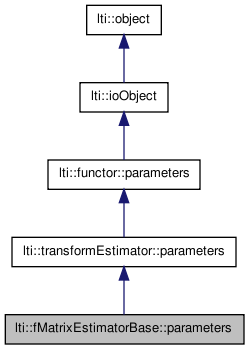

|
latest version v1.9 - last update 10 Apr 2010 |
|
The parameters for the class fMatrixEstimatorBase. More...
#include <ltiFMatrixEstimatorBase.h>


Public Types | |
| enum | eRank2Type |
| enum | eDistanceType |
Public Member Functions | |
| parameters () | |
| parameters (const parameters &other) | |
| ~parameters () | |
| const char * | getTypeName () const |
| parameters & | copy (const parameters &other) |
| parameters & | operator= (const parameters &other) |
| virtual functor::parameters * | clone () const |
| virtual bool | write (ioHandler &handler, const bool complete=true) const |
| virtual bool | read (ioHandler &handler, const bool complete=true) |
Public Attributes | |
| eRank2Type | rank2Enforcement |
| eDistanceType | distanceMeasure |
The parameters for the class fMatrixEstimatorBase.
The distance measure to be used when computing the residual: Sampson or epipolar distance.
The rank 2 constraint may be enforced by the frobenius norm or T-parameterization.
| lti::fMatrixEstimatorBase::parameters::parameters | ( | ) |
Default constructor.
Reimplemented from lti::transformEstimator::parameters.
Reimplemented in lti::fMatrixEstimator::parameters.
| lti::fMatrixEstimatorBase::parameters::parameters | ( | const parameters & | other | ) |
Copy constructor.
| other | the parameters object to be copied |
Reimplemented from lti::transformEstimator::parameters.
Reimplemented in lti::fMatrixEstimator::parameters.
| lti::fMatrixEstimatorBase::parameters::~parameters | ( | ) | [virtual] |
Destructor.
Reimplemented from lti::transformEstimator::parameters.
Reimplemented in lti::fMatrixEstimator::parameters.
| virtual functor::parameters* lti::fMatrixEstimatorBase::parameters::clone | ( | ) | const [virtual] |
Returns a pointer to a clone of the parameters.
Reimplemented from lti::transformEstimator::parameters.
Reimplemented in lti::fMatrixEstimator::parameters.
| parameters& lti::fMatrixEstimatorBase::parameters::copy | ( | const parameters & | other | ) |
Copy the contents of a parameters object.
| other | the parameters object to be copied |
Reimplemented from lti::transformEstimator::parameters.
Reimplemented in lti::fMatrixEstimator::parameters.
| const char* lti::fMatrixEstimatorBase::parameters::getTypeName | ( | ) | const [virtual] |
Returns name of this type.
Reimplemented from lti::transformEstimator::parameters.
Reimplemented in lti::fMatrixEstimator::parameters.
| parameters& lti::fMatrixEstimatorBase::parameters::operator= | ( | const parameters & | other | ) |
Copy the contents of a parameters object.
| other | the parameters object to be copied |
Reimplemented from lti::transformEstimator::parameters.
Reimplemented in lti::fMatrixEstimator::parameters.
| virtual bool lti::fMatrixEstimatorBase::parameters::read | ( | ioHandler & | handler, | |
| const bool | complete = true | |||
| ) | [virtual] |
Read the parameters from the given ioHandler.
| handler | the ioHandler to be used | |
| complete | if true (the default) the enclosing begin/end will be also written, otherwise only the data block will be written. |
Reimplemented from lti::transformEstimator::parameters.
Reimplemented in lti::fMatrixEstimator::parameters.
| virtual bool lti::fMatrixEstimatorBase::parameters::write | ( | ioHandler & | handler, | |
| const bool | complete = true | |||
| ) | const [virtual] |
Write the parameters in the given ioHandler.
| handler | the ioHandler to be used | |
| complete | if true (the default) the enclosing begin/end will be also written, otherwise only the data block will be written. |
Reimplemented from lti::transformEstimator::parameters.
Reimplemented in lti::fMatrixEstimator::parameters.
The distance measure to be used when computing the residual.
The Sampson distance is reported to be superior when iteratively refining the fundamental matrix (e.g. Hartley, Zisserman: 3D Computer Vision), whereas the epipolar distance is equivalent to the residual. Default: Epipolar.
Several ways exist to enforce the rank 2 constraint.
E.g. the fundamental matrix may be replaced by the closest fundamental matrix under the frobenius norm. A different approach is to replace one row and one column by a linear combination of the other two. This is called T-parameterization. The frobenius norm is computational more efficient whereas T-parameterization is reported to produce more accurate results, e.g. when combined with a maximum likelyhood estimator. But with an inaccurate fmatrix estimate the Frobenius norm works better. Default: Frobenius.